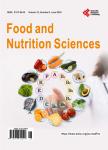The Influence of Apple-or Red-Grape Pomace Enriched Piglet Diet on Blood Parameters,Bacterial Colonisation,and Marker Gene Expression in Piglet White Blood Cells
苹果葡萄或红葡萄的果渣的影响在小猪白血房间在血参数,细菌的殖民地化,和标记基因表示上充实小猪饮食作者机构:Lehrstuhl für Physiologie WeihenstephanZentralinstitut für Ernahrung-und LebensmittelforschungWissenschaftszentrum WeihenstephanTechnische Universitat MünchenFreisingGermany Fachgebiet Obstbau WeihenstephanWissenschaftszentrum WeihenstephanTechnische Universitat MünchenFreisingGermany Institut für Tierernahrung und FutterwirtschaftBayerische Landesanstalt für LandwirtschaftPoing-GrubGermany
出 版 物:《Food and Nutrition Sciences》 (食品与营养科学(英文))
年 卷 期:2011年第2卷第4期
页 面:366-376页
学科分类:1002[医学-临床医学] 100214[医学-肿瘤学] 10[医学]
基 金:This study was supported by the Bayerisches Staatsmin-isterium für Landwirtschaft und Forsten L/a-7606.2-494
主 题:Apple Pomace Red-Grape Pomace White Blood Cells mRNA Gene Expression Blood Parameters Bacterial Colonization
摘 要:Proanthocyanidins and flavanoids, both subfamilies of the polyphenols, are highly concentrated in different fruits and berries as well as in fruit pomace. They have shown to exhibit anti-cancer, anti-microbial, anti-oxidative, and im- mune-modulatory effects in vertebrates. Herein the effect of additional apple pomace or red-grape pomace in conven- tional piglet starter feeds were investigated in 36 young growing piglets. Immunological marker gene expression was quantified by quantitative real-time RT-PCR in white blood cells, and intestinal bacterial flora was investigated from weaning to three weeks post weaning. Polyphenol content in red-grape pomace, gut content and tissues were analyzed with HPLC. Flavan-3-ols (epicatechin and catechin) and proanthocyanidins (B1, B2 and C1) were identified in the gas- tro-intestinal tract content, whereas only traces could be detected in various piglet organs. The blood parameters, he- moglobin and hematocrit, were affected and down-regulated in all groups over testing period. In both pomace treated groups more thrombocytes were present compared to the standard feeding group. It turns out, that the pomace diets had greatest impact on the bacterial content in the colon. Results demonstrate that feeding apple pomace and red- grape pomace tended to increase the number of total colonic bacteria. Steptococci/Enterococci increased in the red- grape pomace. C. perfringens was not detectable at the second time point. The number of lactobacilli increased in both applied diets. The number of Clostridium perfringens decreased with the age of the piglets. Trends of mRNA expression changes were found in white blood cell (WBC) between different feeding regimens, since the expression variability in the groups was very high. Between the different time points there were significant differences within the apple pomace group, where TNF? (p = 0.033), NF?B (p = 0.024) and Caspase 3 (p = 0.019) mRNA expression increased signifi- cantly during treatm



